Semrush Bundle
Who Does Semrush Serve in the Digital Marketing World?
In the ever-evolving digital marketing sphere, understanding customer demographics and the target market is paramount for any company aiming for success. For Semrush, a leading online visibility management SaaS platform, knowing its audience is the cornerstone of its growth and innovation. This knowledge allows the company to tailor its marketing tools and strategies effectively.
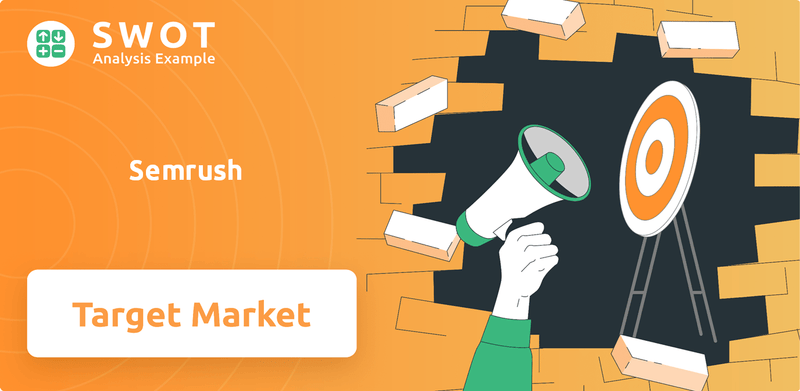
Semrush's journey from an SEO tool to a comprehensive marketing platform showcases its keen understanding of its customer base. This strategic evolution has allowed Semrush to cater to a broad range of users, from SEO specialists to enterprise-level businesses. The following sections will explore the specifics of the Semrush target market, including customer demographics, industry focus, and customer acquisition strategies, providing a detailed audience analysis.
Who Are Semrush’s Main Customers?
Understanding the customer demographics and target market of the Semrush company is crucial for grasping its market position. Semrush primarily focuses on a business-to-business (B2B) model, catering to a diverse range of clients. This includes small and medium-sized businesses (SMBs) to large enterprises and marketing agencies. The primary customer segmentation for Semrush revolves around business size, industry, and specific digital marketing roles.
The core customer base of Semrush consists of digital marketing professionals, SEO specialists, content marketers, PPC managers, social media managers, and marketing agencies. These professionals use Semrush to enhance their online visibility, conduct competitive analysis, and optimize digital marketing campaigns. The company's offerings are tailored to different levels of expertise and business scale, ensuring that both SMBs and large enterprises can effectively utilize its features.
Semrush's ability to serve various business sizes and industries is a key aspect of its customer demographics. For instance, SMBs often use Semrush for foundational SEO and content marketing, while larger enterprises and agencies leverage advanced features for comprehensive competitive analysis and extensive keyword research. Marketing agencies, in particular, form a significant segment, using Semrush to manage client campaigns and demonstrate ROI. As of Q1 2024, Semrush reported over 111,000 paying customers, showcasing its broad appeal across various business types.
The primary users of Semrush are digital marketing professionals. This includes SEO specialists, content marketers, PPC managers, and social media managers. These professionals use Semrush to improve online visibility and optimize marketing campaigns.
Marketing agencies represent a significant segment within Semrush's customer demographics. They use Semrush as a critical tool for managing client campaigns and demonstrating ROI. Semrush helps agencies manage multiple clients and provide data-driven results.
SMBs are a key part of Semrush's customer base. They often use Semrush for foundational SEO and content marketing tasks. Semrush provides SMBs with essential tools to improve their online presence and compete effectively.
Large enterprises also utilize Semrush, leveraging its advanced features for comprehensive competitive analysis and extensive keyword research. These businesses use Semrush to gain deeper insights and optimize their marketing strategies at scale.
Semrush's target audience is primarily composed of digital marketing professionals, marketing agencies, SMBs, and large enterprises. The company's customer segmentation is based on business size, industry, and specific digital marketing roles. This approach allows Semrush to tailor its features and services to meet the varying needs of its diverse customer base.
- Digital Marketing Professionals: SEO specialists, content marketers, PPC managers, and social media managers.
- Marketing Agencies: Agencies that manage client campaigns and need to demonstrate ROI.
- Small and Medium-Sized Businesses (SMBs): Businesses that need foundational SEO and content marketing tools.
- Large Enterprises: Companies that require advanced features for competitive analysis and keyword research.
Semrush continues to evolve its offerings to meet the changing needs of its target market. Over time, Semrush has expanded its target segments to include content creators and public relations professionals, recognizing the increasing convergence of these disciplines with traditional digital marketing. This strategic expansion is supported by market research indicating a broader need for online visibility tools beyond just SEO. For more insights into the business model and revenue streams, you can read about the Revenue Streams & Business Model of Semrush.
Semrush SWOT Analysis
- Complete SWOT Breakdown
- Fully Customizable
- Editable in Excel & Word
- Professional Formatting
- Investor-Ready Format
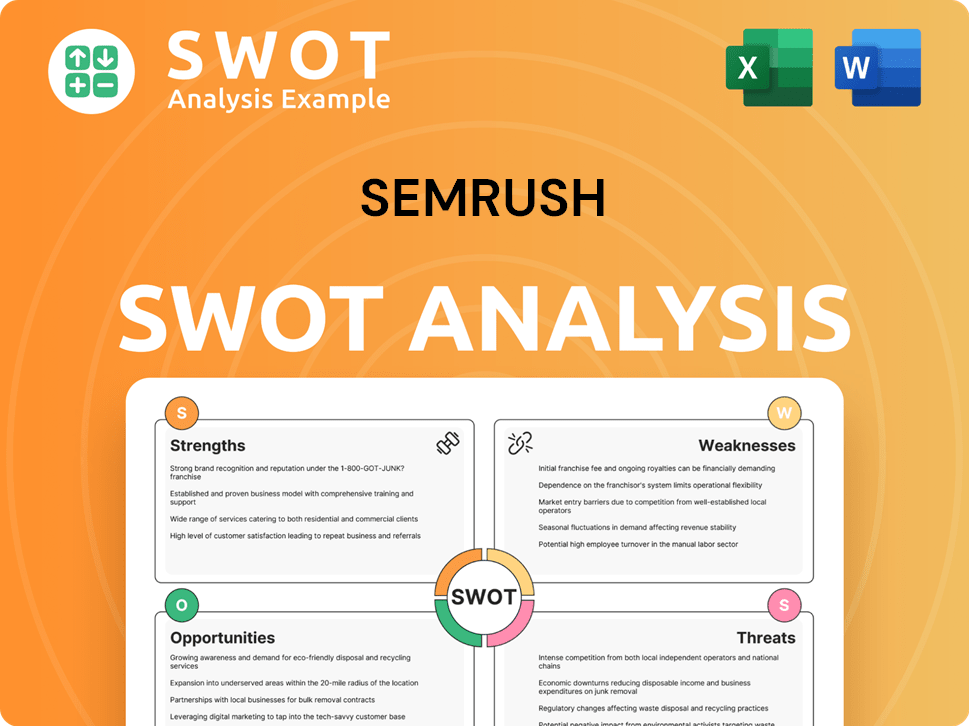
What Do Semrush’s Customers Want?
Understanding the customer needs and preferences is crucial for any business, and for the success of the [Company Name], it's no different. The company's customers are primarily driven by the need to enhance their online visibility, gain insights into their competitors, and streamline their digital marketing processes. This focus on actionable insights is a key factor.
Customers are looking for ways to drive organic traffic, optimize their advertising spending, create engaging content, and effectively manage their social media presence. The purchasing decisions are often influenced by the desire for comprehensive data, user-friendly interfaces, and reliable tools that provide a clear return on investment. The company's ability to meet these needs directly impacts its success.
Decision-making criteria for customers often include the breadth of features, the accuracy of data, the ease of integration with other marketing tools, and the quality of customer support. Addressing these factors is essential for customer satisfaction and retention. The company's success depends on its ability to meet these criteria.
The company addresses common pain points such as identifying profitable keywords, understanding competitor strategies, measuring content performance, and managing complex PPC campaigns. For example, features like competitor keyword research and backlink analysis directly address the need for deep competitive analysis.
The company continuously gathers customer feedback and monitors market trends to influence product development. Recent updates and new features, such as those related to AI-powered content creation and enhanced local SEO tools, reflect evolving customer needs and the broader digital marketing landscape.
The company tailors its marketing and product features by offering different subscription tiers (Pro, Guru, Business) to cater to the varying needs and budgets of its diverse customer segments, from individual marketers to large enterprises. This approach ensures that the product meets the needs of a wide range of users.
The company's commitment to customer satisfaction is reflected in its high gross retention rate, which was 93% in Q1 2024. This high retention rate indicates that the company is effectively meeting the needs of its customers and providing value.
The company's customer acquisition strategy involves a combination of inbound and outbound marketing efforts, including content marketing, SEO, and paid advertising. These strategies are designed to attract and retain customers. Understanding the Owners & Shareholders of Semrush can provide insights into the company's strategic direction.
The company's industry focus includes marketing agencies, e-commerce businesses, and businesses of all sizes that prioritize online visibility and digital marketing. These businesses rely on the company's tools to improve their online presence and achieve their marketing goals.
The company's customers have several key needs that drive their use of the platform. These needs are addressed through various features and services offered by the company.
- Comprehensive Data: Customers need access to accurate and in-depth data to make informed decisions.
- User-Friendly Interface: The platform must be easy to navigate and use, even for those new to digital marketing.
- Actionable Insights: Customers need insights that can be directly applied to improve their marketing strategies.
- Competitive Intelligence: Understanding competitor strategies is crucial for staying ahead in the market.
- Integration with Other Tools: Seamless integration with other marketing tools is essential for efficiency.
Semrush PESTLE Analysis
- Covers All 6 PESTLE Categories
- No Research Needed – Save Hours of Work
- Built by Experts, Trusted by Consultants
- Instant Download, Ready to Use
- 100% Editable, Fully Customizable
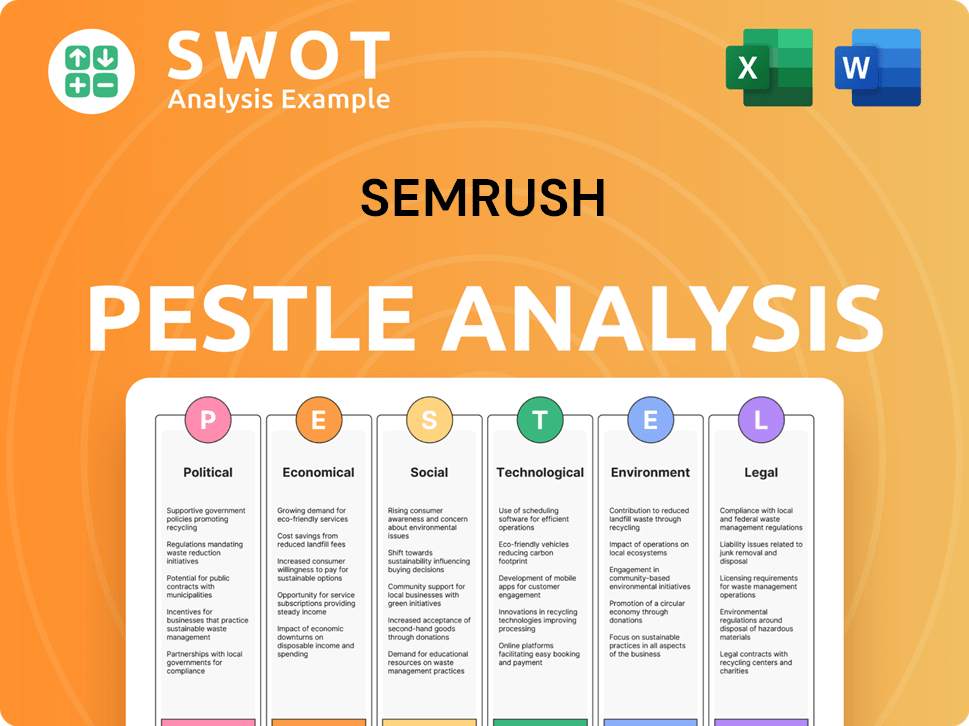
Where does Semrush operate?
The geographical market presence of the company is a key factor in its overall success. The company has established a strong global footprint, with a significant presence in North America, Europe, and the Asia-Pacific region. This widespread reach allows it to serve a diverse customer base and capitalize on opportunities in various digital marketing landscapes.
The United States remains a dominant market for the company, where it has a strong market share and brand recognition. However, the company has also strategically expanded its reach across Europe, including the UK, Germany, France, and Spain. These regions are crucial due to the high levels of digital marketing activity and the demand for advanced marketing tools.
Understanding the nuances of each region is essential for the company's success. The company adapts its strategies based on customer demographics, preferences, and buying power. This includes localizing content, marketing materials, and sales and support teams to cater to specific regional markets. This approach is vital for customer acquisition and retention.
The company's customer demographics are diverse, spanning various industries and company sizes. The company serves a broad range of customers, including small businesses, marketing agencies, and large enterprises. Its tools cater to different skill levels, from beginners to experienced marketing professionals.
The Semrush target market is primarily digital marketing professionals, SEO specialists, content marketers, and business owners. The company's tools are designed to meet the needs of anyone involved in online marketing. Its target audience characteristics include a focus on data-driven decision-making and a desire to improve online visibility.
The company uses customer segmentation to tailor its offerings and marketing efforts. This involves categorizing customers based on industry, company size, and marketing goals. This approach helps the company provide relevant solutions and improve customer satisfaction. Understanding Semrush user profiles is key.
The company employs a multi-faceted customer acquisition strategy. This includes content marketing, SEO, paid advertising, and partnerships. The company focuses on attracting customers through valuable content and demonstrating the benefits of its marketing tools. Learn more in the Marketing Strategy of Semrush.
The company's global expansion strategy is evident in its revenue distribution. As of Q1 2024, 58% of its revenue came from outside the United States, indicating a strong international presence. This demonstrates the company's ability to attract and retain customers worldwide.
- The company's customer base size continues to grow, reflecting the increasing demand for its services.
- The company's industry focus includes marketing agencies, e-commerce businesses, and SaaS companies.
- The company's pricing plans for target markets are designed to be competitive and accessible to various customer segments.
- The company continuously analyzes customer needs and customer pain points to improve its offerings.
Semrush Business Model Canvas
- Complete 9-Block Business Model Canvas
- Effortlessly Communicate Your Business Strategy
- Investor-Ready BMC Format
- 100% Editable and Customizable
- Clear and Structured Layout
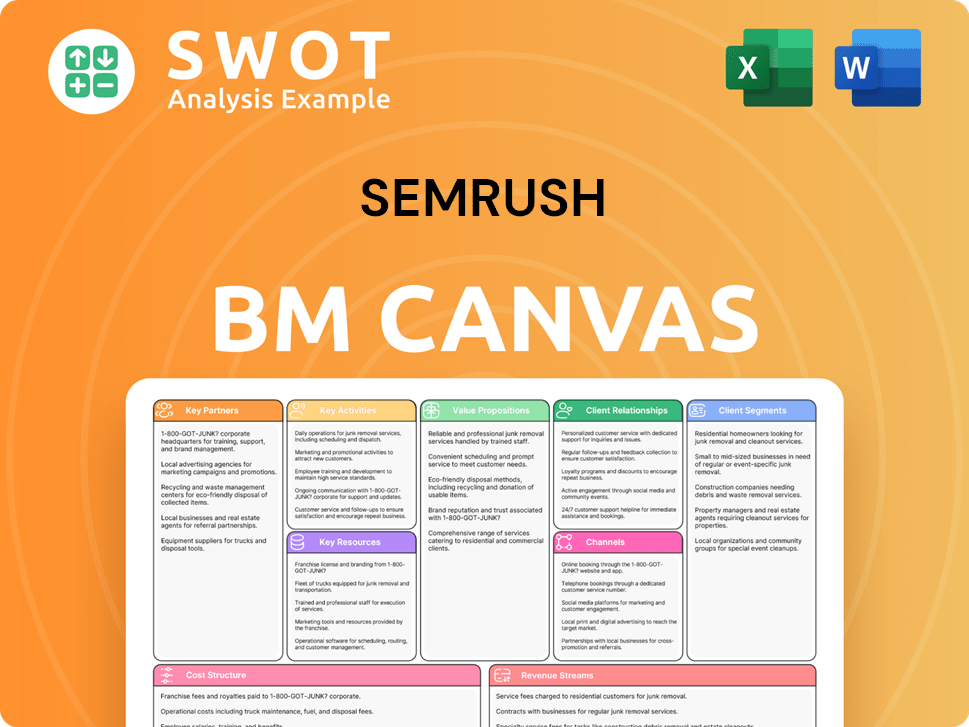
How Does Semrush Win & Keep Customers?
The company employs a multi-faceted approach to customer acquisition and retention, focusing on digital marketing, sales, and customer success initiatives. This strategy is key to understanding the Semrush target market and maintaining a strong customer base. A deep dive into these strategies reveals how the company attracts and retains its users.
A significant portion of customer acquisition is driven through content marketing and organic search. The company's own SEO performance serves as a testament to its product's efficacy, showcasing its ability to rank well in search results. Paid advertising and social media marketing further expand its reach, generating leads and targeting specific customer demographics.
Customer retention strategies include excellent support, educational resources, and continuous platform updates. Loyalty programs, such as tiered subscription models, provide more advanced features and support to long-term customers. The company's high gross retention rate of 93% in Q1 2024, and a net retention rate of 105% in the same period, highlight the success of these strategies.
Content marketing and organic search are significant drivers of customer acquisition. The company's own SEO success demonstrates its product's effectiveness. This approach helps in attracting customers through valuable content and high search rankings.
Paid advertising (PPC) and social media marketing are used to reach new audiences and generate leads. These channels help to target specific customer demographics and increase brand visibility. This strategy ensures a wider reach and attracts potential customers.
A freemium model allows potential customers to experience limited features before committing to a paid subscription. A direct sales force is in place for larger accounts. These tactics help convert free users into paying customers.
Exceptional customer support, comprehensive educational resources, and continuous platform updates are key retention strategies. This includes the Semrush Academy and blog. These resources help users maximize the value of the platform.
Understanding and addressing Semrush customer needs is crucial for both acquisition and retention. The company continuously updates its platform to meet evolving market demands. This approach ensures that the platform remains relevant and valuable to its users.
- Identify Semrush customer pain points through feedback and market research.
- Develop features and solutions that directly address these pain points.
- Provide excellent customer support to resolve issues quickly and efficiently.
- Offer comprehensive educational resources to help users maximize the platform's value.
Semrush Porter's Five Forces Analysis
- Covers All 5 Competitive Forces in Detail
- Structured for Consultants, Students, and Founders
- 100% Editable in Microsoft Word & Excel
- Instant Digital Download – Use Immediately
- Compatible with Mac & PC – Fully Unlocked
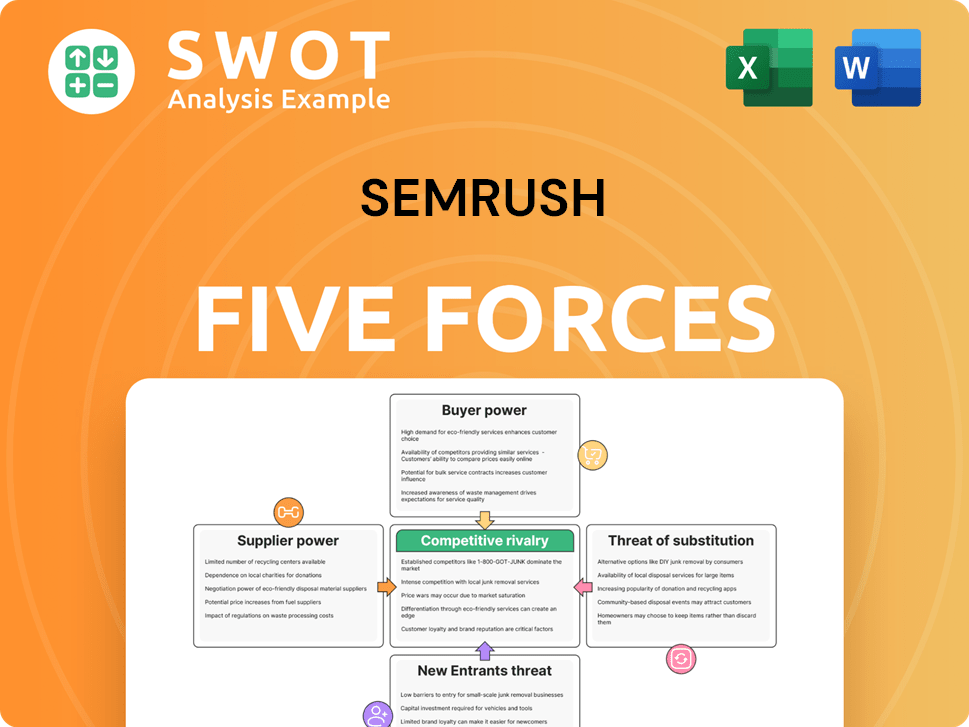
Related Blogs
- What are Mission Vision & Core Values of Semrush Company?
- What is Competitive Landscape of Semrush Company?
- What is Growth Strategy and Future Prospects of Semrush Company?
- How Does Semrush Company Work?
- What is Sales and Marketing Strategy of Semrush Company?
- What is Brief History of Semrush Company?
- Who Owns Semrush Company?
Disclaimer
All information, articles, and product details provided on this website are for general informational and educational purposes only. We do not claim any ownership over, nor do we intend to infringe upon, any trademarks, copyrights, logos, brand names, or other intellectual property mentioned or depicted on this site. Such intellectual property remains the property of its respective owners, and any references here are made solely for identification or informational purposes, without implying any affiliation, endorsement, or partnership.
We make no representations or warranties, express or implied, regarding the accuracy, completeness, or suitability of any content or products presented. Nothing on this website should be construed as legal, tax, investment, financial, medical, or other professional advice. In addition, no part of this site—including articles or product references—constitutes a solicitation, recommendation, endorsement, advertisement, or offer to buy or sell any securities, franchises, or other financial instruments, particularly in jurisdictions where such activity would be unlawful.
All content is of a general nature and may not address the specific circumstances of any individual or entity. It is not a substitute for professional advice or services. Any actions you take based on the information provided here are strictly at your own risk. You accept full responsibility for any decisions or outcomes arising from your use of this website and agree to release us from any liability in connection with your use of, or reliance upon, the content or products found herein.